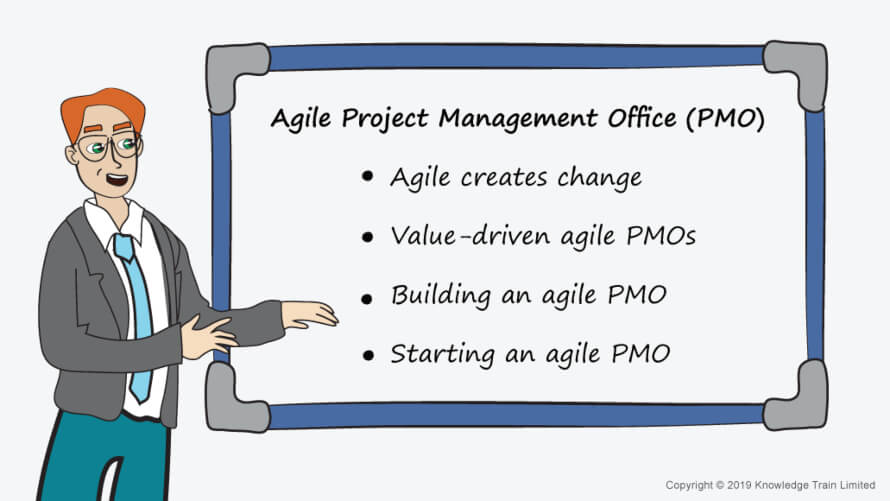
Introduction

PMOs have been a common feature on projects in larger organizations. However, in the last decade or so, the responsibilities of PMOs have evolved into a much wider brief. Nowadays, PMOs are also expected to support both portfolios and programmes, in addition to their traditional project management brief.
Agile creates change
When an organization tries to adapt agile practices on its projects, it is setting out on a programme of change. These changes can affect stakeholders beyond the usual realm of the project. Therefore, to support the change to agile, a PMO must also change.
Value-driven agile PMOs
All projects should deliver the optimum value, to the right stakeholders, at the right time. A PMO objective is to smooth the path to achieving these goals.
Just as agile itself is a customer-focused mindset, an agile PMO must be based upon a customer-collaboration mindset.
PMOs should tailor the support they give to projects depending upon the project’s unique circumstances. In the same way, an agile PMO should tailor its agile support to what each project needs to deliver the value the customer is expecting. Some might need specific assistance with training and coaching team members in certain agile practices. Others might need tools and templates.
Agility requires practitioners adapt quickly to change. Therefore, an agile PMO must have its pulse on the customer to understand what it truly needs.
Building an agile PMO
When starting out building an agile PMO, it is tempting to think of mandating a set of agile practices and templates across projects. That would be a mistake.
Becoming an agile organization requires the employees themselves understand why the change is taking place and having them take a role as active participants.
Often when organizations mandate a top-down change, the initiative fails because the staff do not buy into the change.
Therefore, a much better approach to building an agile PMO is to let the project participants come to the agile PMO. When actively seeking the help of an agile PMO, those staff are far more likely to engage with the PMO than if it is mandated from the top down.
Starting an agile PMO
One key question to answer is ‘how to start building an agile PMO?’ After all, if the agile PMO is to get its first customers, there must be an initial project where its support is trialled and championed.
The solution is to find a project, probably small, on which the team members are keen to try agile. Then to provide the training, mentoring and coaching to implement sensible agile practices and tools on that project.
The team should measure progress solely on its ability to deliver working products early and regularly. The team must be based around self-motivated people who collaborate with the business. To minimize waste, the team should keep things simple. The team should also have regular retrospectives to improve the agile processes being used.
Multi-skilled agile PMOs
Since moving an organisation from a more predictive, functional style organization to a more agile organisation required organizational change management. Therefore, the agile PMO must become conversant with organisational change management frameworks, tools and techniques.
This therefore requires the PMO and its staff to become more than just project management experts.
Centres of excellence
Some agile PMOs deal with the challenges of helping organizations become more agile by becoming centres of excellence which provide a range of services. The best practice PMO framework P3O describe the role and function of a PMO centre of excellence. This kind of PMO structure provides some of these services:
Developing and implementing standards
Providing agile templates e.g. for user stories, test cases), and standardizing the use of agile toolsets.
Developing personnel
Coordinating agile training, coaching, and mentoring to help team members and business leaders’ transition to an agile mindset.
Multi-project management
Coordinating projects between agile teams. Some of this can be done by sharing things such as progress, issues, risks and retrospective findings and improvements. Another way is by using appropriate portfolio and programme management frameworks to provide decision-making support for investment decisions taken at the portfolio and programme levels.
Facilitating organisational learning
Gathering, storing and disseminating project metrics and retrospective findings.
Managing stakeholders
Providing support and training for business leaders, especially in the product owner role, on things such as acceptance testing, and how to evaluate and give feedback on systems.
Conclusion
As organisations grapple with the challenges of becoming more agile, there is an increasing awareness that to succeed requires understanding more than just agile practices and project management.
To move to greater agility requires the organisation to understand that what in fact it is undertaking, is organizational change. Therefore, the people driving these changes must understand and be able to apply some of the well-established frameworks, techniques and bodies of knowledge that form the change management profession.
Relying only on agile gurus to coach team members is only one small part of a much bigger jigsaw puzzle requiring an organisational change management approach.
